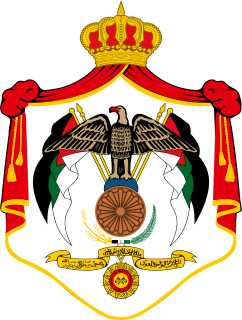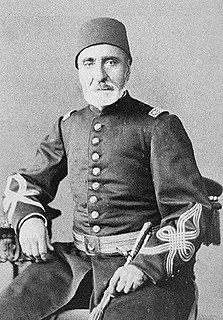
The "National Anthem of Chile", also known as "Canción Nacional" or by its incipit "Puro, Chile, es tu cielo azulado", was adopted in 1828. It has a history of two lyrics and two melodies that made up three different versions. The current version was composed by Ramón Carnicer, with words by Eusebio Lillo, and has six parts plus the chorus.

"The Star-Spangled Banner" is the national anthem of the United States. The lyrics come from the "Defence of Fort M'Henry", a poem written on September 14, 1814, by 35-year-old lawyer and amateur poet Francis Scott Key after witnessing the bombardment of Fort McHenry by British ships of the Royal Navy in Outer Baltimore Harbor in the Patapsco River during the Battle of Baltimore in the War of 1812. Key was inspired by the large U.S. flag, with 15 stars and 15 stripes, known as the Star-Spangled Banner, flying triumphantly above the fort during the U.S. victory.

Josef Anton Bruckner was an Austrian composer, organist, and music theorist best known for his symphonies, masses, Te Deum and motets. The first are considered emblematic of the final stage of Austro-German Romanticism because of their rich harmonic language, strongly polyphonic character, and considerable length. Bruckner's compositions helped to define contemporary musical radicalism, owing to their dissonances, unprepared modulations, and roving harmonies.

The "Hymn to Liberty", or "Hymn to Freedom", is a poem written by Dionysios Solomos in 1823 that consists of 158 stanzas and is used as the national anthem of Greece and Cyprus. It was set to music by Nikolaos Chalikiopoulos Mantzaros in 1865 and is the longest national anthem in the world by length of text. It officially became the national anthem of Greece in 1865 and Cyprus in 1966.

"Aegukga", often translated as "The Patriotic Song", is the national anthem of Republic of Korea. It was adopted in 1948, the year the country was founded. Its music was composed in the 1930s and arranged most recently in 2018; its lyrics date back to the 1890s. The lyrics of "Aegukga" were originally set to the music of the Scottish song "Auld Lang Syne" before Ahn Eak-tai composed a unique melody specifically for it in 1936. Before the founding of South Korea, the song's lyrics, set to the music of "Auld Lang Syne", was sung, as well as during Korea under Japanese rule by dissidents. The version set to the melody composed by Ahn Eak-tai was adopted as the national anthem of the Korean exile government, which existed during Korea's occupation by Japan from the early 1910s to the mid-1940s.

The Marcha Real is the national anthem of Spain. It is one of only four national anthems in the world, along with those of Bosnia and Herzegovina, San Marino and Kosovo — that have no official lyrics. Although it had lyrics in the past, they are no longer used.

"Lijepa naša domovino" is the national anthem of Croatia. Often simply referred to as "Lijepa naša" in Croatia, it is a phrase widely used as a metonym for the country.

"The Royal Anthem of Jordan" is the national anthem of Jordan, adopted in 1946. The lyrics were written by ʿAbdel Munʿim al-Rifāʿī, and the music was composed by ʿAbdul al-Qādir al-Tanīr. The first version of the lyrics was very short, as it only contained the first stanza of the current version. Since then, the anthem has been expanded. The abridged version of the anthem is usually used, while the full version is reserved for special occasions.

Pascal Bruckner is a French writer, one of the "New Philosophers" who came to prominence in the 1970s and 1980s. Much of his work has been devoted to critiques of French society and culture.

The Ottoman Empire used anthems since its foundation in the late 13th century, but did not use a specific imperial or national anthem until the 19th century. During the reign of Mahmud II, when the military and imperial band were re-organized along Western European lines, Giuseppe Donizetti was invited to head the process. Donizetti Pasha, as he was known in the Ottoman Empire, composed the first Western European-style imperial anthem, the Mahmudiye Marşı.

"Dap Prampi Mesa Moha Chokchey" was the national anthem of Democratic Kampuchea from at least January 1976. Although the anthem may have been in use in the "liberated zone" much earlier, it was proclaimed the national anthem in article 18 of the Constitution of Kampuchea which was promulgated on 5 January 1976. Supposedly, the Khmer Rouge and/or Pol Pot himself wrote the piece, but its origin remains unknown.

The state anthem of the Republic of Kazakhstan, simply referred to in Kazakh as "Menıñ Qazaqstanym", became the national anthem of Kazakhstan on 7 January 2006, replacing the previous one since independence in 1991, which used the same melody as the anthem of the Kazakh Soviet Socialist Republic.

The anthem for a person, office or rank is music played on formal or ceremonial occasions in the presence of the person, office-holder, or rank-holder, especially by a military band. The head of state in many countries is honored with a prescribed piece of music; in some countries the national anthem serves this purpose, while others have a separate royal, presidential, or, historically, imperial anthem. Other officials may also have anthems, such as the vice-regal salute in several Commonwealth realms for the Governor-General, Governor, or Lieutenant Governor. Ruffles and flourishes may be played instead of, or preceding, such an anthem.

The Te Deum in C major, WAB 45, is a setting of the Te Deum hymn, composed by Anton Bruckner for SATB choir and soloists, orchestra, and organ ad libitum.
Anthem of China may refer to:
"What Keeps Mankind Alive?" is a song composed by Kurt Weill with lyrics by Bertolt Brecht for their music drama The Threepenny Opera which premiered in Berlin in 1928 at the Theater am Schiffbauerdamm. The title refers to the central line from the finale of act 2, Denn wovon lebt der Mensch?. In the opera, the two stanzas of the strophic piece are sung by Macheath and Mrs Peachum and the final line is sung in fortissimo by the chorus.

The Marsch in E-flat major, WAB 116, is a military march composed by Anton Bruckner in 1865.

Ītyoṗya, Ītyoṗya, Ītyoṗya, qidämī was the national anthem of Ethiopia from 1975 to 1992, during the Derg military junta of Mengistu Haile Mariam. The anthem was first performed on Revolution Day on 12 September 1975. When the junta was reorganized in 1987 as the People's Democratic Republic of Ethiopia, the song was retained until 1992. The lyrics were written by poet Assefa Gebre-Mariam Tesema, and the music was composed by musician Daniel Yohannes Haggos.















